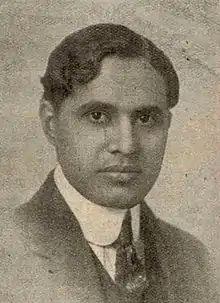Vaman R. Kokatnur
Vaman Ramachandra Kokatnur (1887 – 18 April 1950) was an American chemist of Indian origin. He was an industrial chemist with Niagara Alkali Company and patented several chemical processes, particularly the use of catalysts in organic synthesis.[1][2]

Kokatnur was born in Kokatnur, Athani and after a BSc from Bombay University (1912) he moved to the US, graduating MS from the University of Minnesota in 1914. He received a Shevlin fellowship during this period.[3] He became an American citizen in 1921.[4] In 1928 he was sent to Russia as a consultant for the production of chlorine and caustic soda. During World War II he was drafted into the Navy as a special consultant with the rank of captain. Like many Indian immigrants into the US in the period he supported Indian Independence while considering caste and class hierarchies as necessities in society.[5] In 1948 he examined chemistry in ancient Indian literature and claimed that the ancients must have had considerable knowledge based on his interpretation of various arms mentioned in the Ramayana translations made by other authors.[6][7] He was noted as being interested in the hieroglyphics which he believed was related to Sanskrit. At a meeting of the American Chemical Society he claimed that Indians had discovered hydrogen and oxygen and that chemistry was of Aryan origin. He said he had identified this from a four page manuscript from 1550 claimed to be the Agastya Samhita or writings of Sage Agastya who lived in 2000 BC. According to Kokatnur, the gods Mitra and Varuna mentioned in the work was on electrolysis and was to be interpreted as Mitra meaning friend, and therefore the cathode, and Varuna meaning liquid or enemy of zinc and therefore referring to the anode. He also claimed that "prana" meant vital to life and therefore indicated oxygen while "udana" meant facing upward and therefore identifiable as hydrogen. About the source and its provenance he claimed that it could not have been a fake because the paper was older than 50 years and that findings on preventing polarization were recent. His work was supposedly to be published in the science history journal Isis but given the dubiousness surrounding the provenance of sources and the interpretations, was apparently never published.[8][9]
References
- Kokatnur, V. R. (1919). "THE INFLUENCE OF CATALYSTS ON THE CHLORINATION OF HYDROCARBONS". Journal of the American Chemical Society. 41 (1): 120–124. doi:10.1021/ja01458a013. ISSN 0002-7863.
- Radford, A. J. (1954). "Investigation of the Kokatnur-Jelling method for the determination of benzoyl peroxide". The Analyst. 79 (941): 501. doi:10.1039/an9547900501. ISSN 0003-2654.
- "Student loans model of Taj Mahal" (PDF). The Minnesota Alumni Weekly. 14 (27): 8. 1915.
- "News and Notes". Science. 111 (2888): 503–506. 1950. ISSN 0036-8075.
- Kokatnur, V. R. (1928). "The teaching of chemistry in a democracy". Journal of Chemical Education. 5 (3): 301. doi:10.1021/ed005p301. ISSN 0021-9584.
- Kokatnur, V. R. (1948). "Chemical warfare in Ancient India". Journal of Chemical Education. 25 (5): 268–272. doi:10.1021/ed025p268.
- "Vaman Ramachandra Kokatnur". Science and Culture. 16 (1): 20.
- "First non-stop flight made 2000 years BC. Revelations of ancient manuscripts, discovered by alumnus, prove that ancient Hindus knew how to fly, knew that hydrogen was lighter than air and knew how to make dry batteries". The Minnesota Alumni Weekly. 27 (3): 59–60, 66. October 15, 1927.
- Colavito, Jason (2015). "Did an Ancient Indian Sage Record a Recipe for Making a Battery? A Forgotten Chapter in Fringe History".
External links
- MS thesis - The action of trioxymethylene on the various organic compounds in the presence of aluminium chloride.
- Patents - US 2121545A US 2461580A US 2350906A US 1753659A US 2211855A US 2111973A US 2152196A US 2218336A US 2296558A US 2326099A US 1813454A US 2394244A US 2435544A US 2268122A US 2320242A US 2209681A US 2435314A US 1667480A US 2218172A US 2111100A